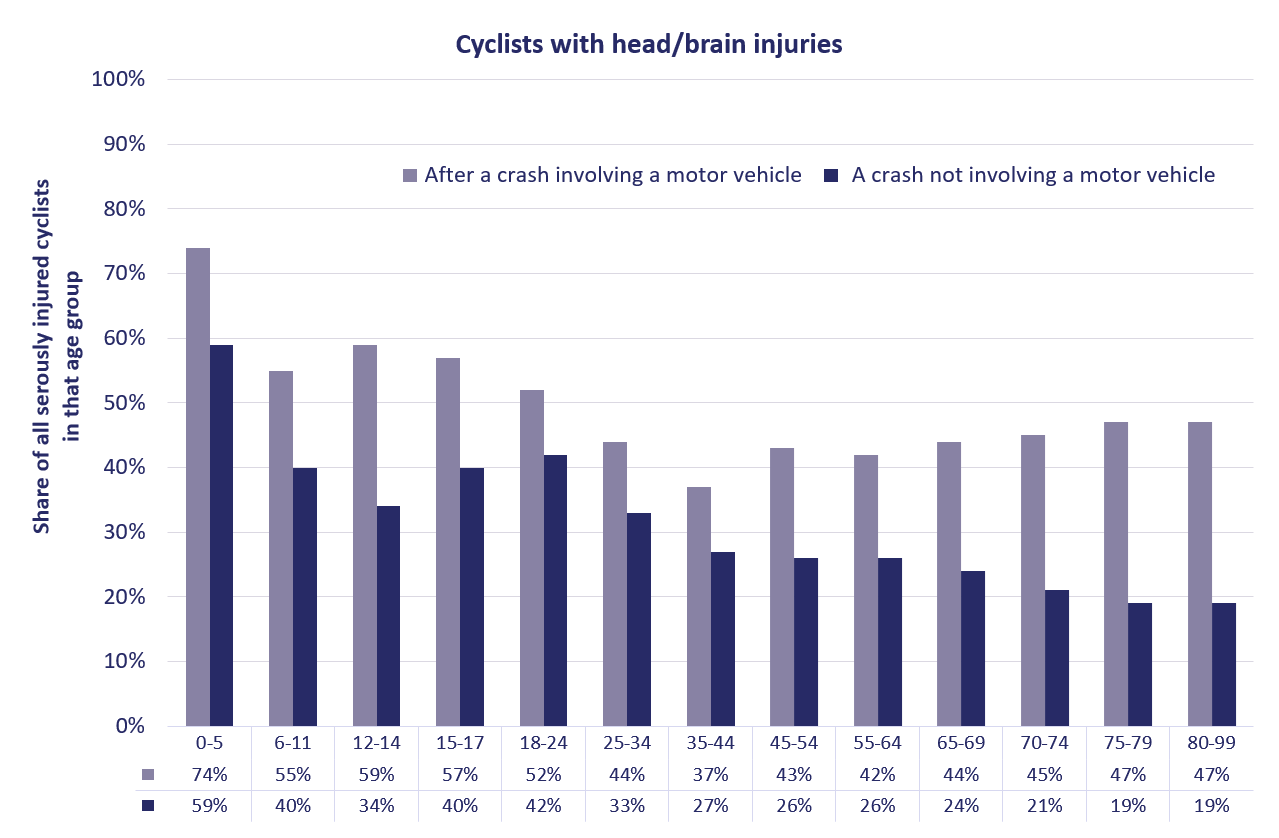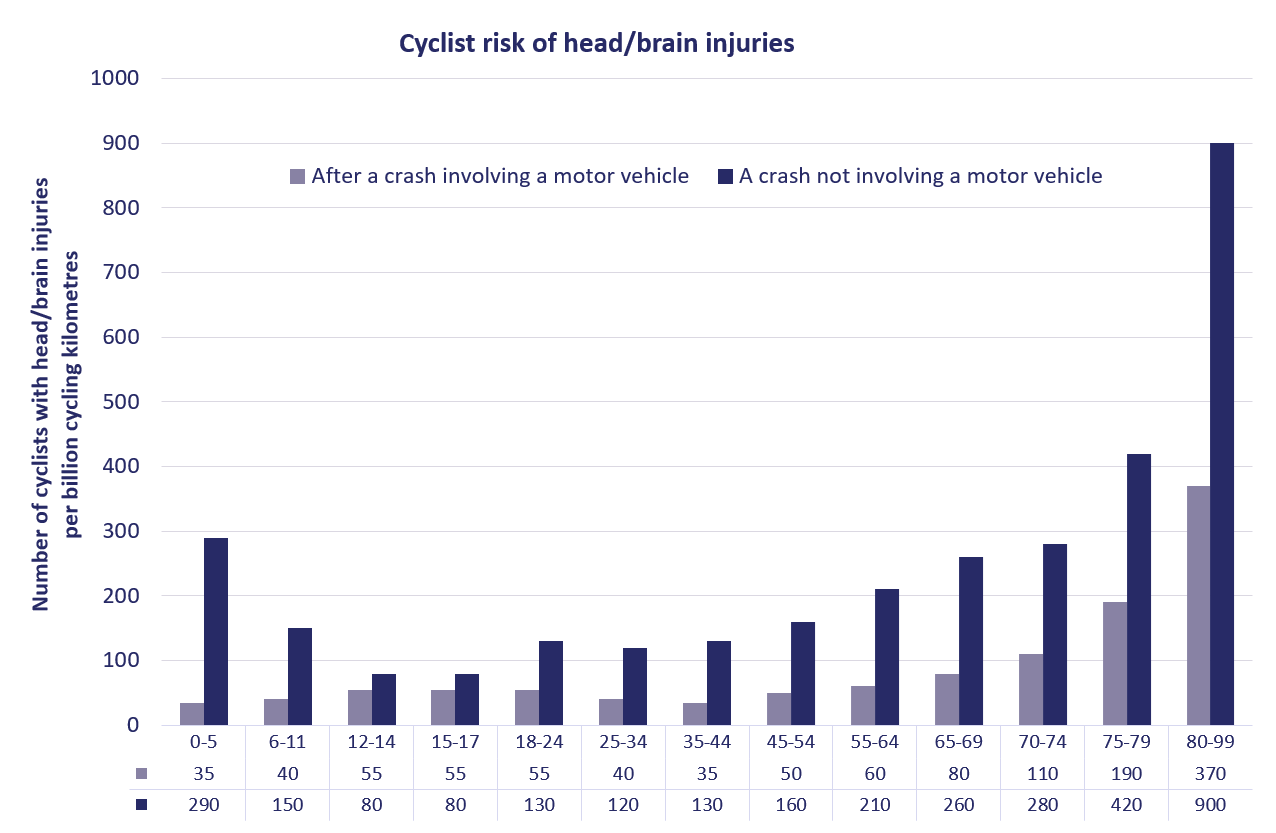SWOV has estimated the potential reduction of cycling casualties in the Netherlands if all cyclists wore helmets at all times [39]. This amounts to an annual decrease of 85 road deaths and of 2500-2600 serious road injuries (see Table 2). The estimate has been based on bicycle helmet effectiveness from a recent meta-analysis [28]. Also see the question How effective are bicycle helmets in preventing (fatal) head injuries among cyclists? relative to the prevalence of (serious) head and brain injuries among cyclists. The estimate of the effectiveness of helmets has exclusively been based on international research. Considering bicycle usage and the available (cycling) infrastructure in the Netherlands, it cannot be stated with any certainty whether the effect in the Netherlands would be the same. There are, however no concrete indications for a different outcome.
|
Target group |
Effect on road deaths |
Effect on serious road injuries |
|
All cyclists |
85 |
2500 – 2600 |
|
Children (< 12) |
< 5 |
200 |
|
Senior citizens (> 70) |
45 - 50 |
900 |
Table 2. Potential effects of an increase in helmet use from 0% to 100%. The effects are rounded up to the nearest multiple of 5 (deaths) and 100 (serious road injuries). Source: [39].
Head and brain injuries are relatively common among cyclists. Almost one-third of all cyclists with serious injuries after a crash sustain head or brain injuries. In crashes involving motor vehicles, almost half of the cyclists sustain head or brain injuries (47%); in bicycle crashes without involvement of motor vehicles, this goes for over a quarter of them (28%; see Figure 1 and also SWOV fact sheet Serious road injuries in the Netherlands. Head and brain injuries mean brain injuries in 86% of the cases, the remaining 14% concern head injuries without damage to the brain.
 Figure 1. Annual percentage of cyclists with serious head/brain injuries (MAIS2+) as main or secondary diagnosis, the number relative to all hospitalised seriously injured cyclists in that age group; over the period 2010-2014 (Sources: Dutch Hospital Data – LMR/LBZ; CBS – Onderzoek Verplaatsingen in Nederland).
Figure 1. Annual percentage of cyclists with serious head/brain injuries (MAIS2+) as main or secondary diagnosis, the number relative to all hospitalised seriously injured cyclists in that age group; over the period 2010-2014 (Sources: Dutch Hospital Data – LMR/LBZ; CBS – Onderzoek Verplaatsingen in Nederland).
 Figure 2. Annual number of cyclists with serious head/brain injuries (MAIS2+) as main or secondary diagnosis (rounded up to the nearest multiple of five) per billion cycling kilometres (risk); for different age groups over the period 2010-2014 (Sources: Dutch Hospital Data – LMR/LBZ; CBS – Onderzoek Verplaatsingen in Nederland).
Figure 2. Annual number of cyclists with serious head/brain injuries (MAIS2+) as main or secondary diagnosis (rounded up to the nearest multiple of five) per billion cycling kilometres (risk); for different age groups over the period 2010-2014 (Sources: Dutch Hospital Data – LMR/LBZ; CBS – Onderzoek Verplaatsingen in Nederland).
In the Netherlands, there is hardly any support for general mandatory helmet use, not even among traffic organisations [23]. Often-repeated arguments against mandatory usage are that the effect is overrated, since cyclists and (other road users) will behave more unsafely; that head injuries may indeed be prevented, but that neck injuries will occur more often; and, above all, that mandatory helmet use will result in less cycling. The question Do bicycle helmets also have adverse effects? explores each of these arguments.
